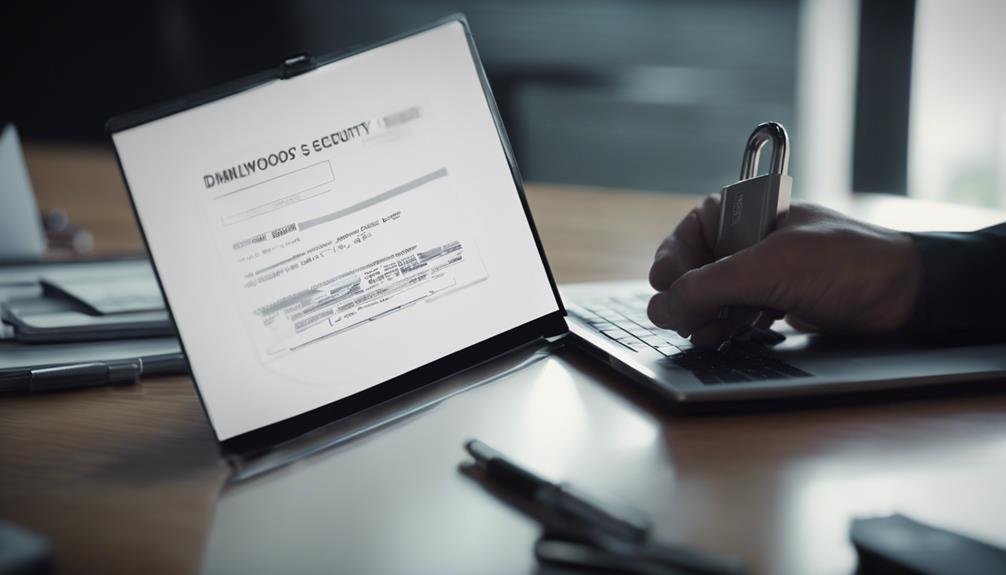Effective governance strategies for digital contracts encompass several vital elements. Define clear objectives, including the purpose, scope, and KPIs. Utilize contract lifecycle management to streamline processes via centralized platforms. Employ secure e-signature solutions for legality and efficiency. Leverage AI and machine learning to automate tasks and provide insights. Regular audits are vital to identify gaps and guarantee compliance. Legal adherence to electronic signature laws and international standards like GDPR is essential. Providing thorough training and accessible support helps users navigate complexities. Promoting transparency and seeking stakeholder feedback further enhance governance practices. Discover the intricate details of these strategies to optimize your digital contracts.
Table of Contents
Brief Overview of Effective Governance Strategies For Smart Contracts
- Define clear and specific objectives to guide contract governance.
- Establish measurable KPIs for tracking contract performance and progress.
- Utilize centralized platforms to streamline and optimize contract management.
- Ensure compliance with electronic signature laws for validity and enforceability.
- Conduct regular audits to identify and address gaps and inefficiencies.
Define Contract Objectives
Defining clear and specific contract objectives is essential for aligning with organizational goals and strategies. To achieve this, it is crucial to delineate the contract’s purpose, scope, deliverables, and timeline in detail to avoid any ambiguities and misunderstandings. Establishing measurable key performance indicators (KPIs) is crucial for tracking progress and evaluating the contract’s success. These KPIs should be directly linked to the defined objectives and organizational goals, providing a clear metric for performance assessment.
Furthermore, assigning roles and responsibilities to all parties involved in the contract fosters accountability and effective collaboration. By clearly outlining who is responsible for each aspect of the contract, organizations can ensure that tasks are completed efficiently and that there is a clear point of contact for any issues.
Regularly reviewing and updating contract objectives is critical to adapt to changing business needs and priorities. The dynamic nature of business environments necessitates that contracts remain flexible and responsive to change. By periodically evaluating and adjusting objectives, organizations can maintain alignment with their goals and ensure the contract remains relevant and effective in achieving its intended outcomes.
Implement Contract Lifecycle Management
Implementing Contract Lifecycle Management (CLM) is essential for organizations to streamline and optimize their contract processes from inception to renewal. CLM solutions offer a centralized platform for managing digital contracts, providing improved visibility and control over the entire contract lifecycle. By automating critical tasks and workflows, contract management software reduces manual errors, accelerates contract processes, and guarantees regulatory compliance.
A key advantage of CLM is its ability to effectively track critical contract milestones, obligations, and performance metrics. This capability enhances contract governance by providing a structured framework for managing and optimizing contract processes. By consolidating contracts in one platform, organizations can easily monitor and audit their agreements, ensuring all terms and conditions are met.
In addition, CLM technology improves efficiency by reducing the time and resources needed for contract creation, execution, and monitoring. Automated alerts and notifications help manage deadlines and renewals, preventing lapses in compliance. Moreover, contract management software allows for seamless collaboration between various departments, making the contract lifecycle more transparent and efficient.
Utilize E-Signature Solutions

E-signature solutions, such as DocuSign and Adobe Sign, offer secure and legally binding methods for signing digital contracts, greatly enhancing efficiency and compliance in contract management. These solutions streamline the signing process by eliminating the need for physical signatures and paperwork, significantly reducing the time and effort required to finalize agreements.
Adopting e-signature solutions guarantees that contracts are completed swiftly and accurately, minimizing errors that often occur with manual processes. This improvement in efficiency not only saves time but also reduces the administrative burden on all parties involved. Moreover, the secure nature of e-signature platforms ensures that the integrity of digital contracts is maintained, providing a reliable and tamper-proof method for executing agreements.
In addition to enhancing efficiency, e-signature solutions ensure compliance with electronic signature laws and regulations, which is essential for the legal enforceability of digital contracts. By adhering to these regulatory standards, organizations can confidently utilize e-signatures without concerns over legal validity. The user-friendly experience offered by these solutions also improves overall contract governance by making the signing process more accessible and convenient for all parties. Therefore, incorporating e-signature solutions is an essential strategy for effective digital contract management.
Leverage AI and Machine Learning
Leveraging AI and machine learning in digital contract governance allows organizations to automate repetitive tasks, improving accuracy and significantly reducing the risk of errors. These technologies play an essential role in Contract Management and Digital Contract Management by systematically analyzing data to identify patterns, trends, and potential risks. This analytical capability enhances decision-making processes and supports effective risk mitigation strategies.
AI and machine learning streamline various stages of contract management, from creation and negotiation to ongoing management. Organizations can increase efficiency and productivity by automating these processes, freeing up valuable resources for more strategic tasks. Additionally, these technologies provide insights into contract performance, compliance issues, and optimization opportunities, ensuring that contracts are aligned with governance standards.
Furthermore, AI and machine learning assist organizations in staying ahead of regulatory changes, thereby enhancing Contract Governance. The improved contract visibility enabled by these technologies ensures compliance requirements are consistently met, reducing the likelihood of non-compliance penalties. In summary, integrating AI and machine learning into digital contract management systems boosts operational efficiency. It fortifies the governance framework, ensuring a robust and compliant contract lifecycle.
Conduct Regular Audits

Regular audits are essential for ensuring that the efficiencies gained through AI and machine learning in digital contract governance are sustained and aligned with regulatory standards. By conducting regular audits, organizations can identify gaps, inefficiencies, and compliance issues within their contract management processes. These audits provide invaluable insights into the effectiveness of existing practices and highlight areas that require improvement.
In contract governance, alignment with legal and regulatory requirements is paramount. Regular audits serve this purpose by systematically evaluating contract management processes against current laws and regulations, thereby mitigating risks associated with non-compliance. Continuous auditing, in particular, is critical for maintaining transparency and accountability, as it allows for ongoing assessment and adaptation.
Moreover, audits are an essential source of stakeholder feedback, offering a structured approach to gathering insights from various parties involved in contract management. This feedback can be leveraged to enhance processes and foster better stakeholder collaboration. Ultimately, the practice of conducting regular audits not only fortifies compliance and efficiency but also builds a robust framework for continuous improvement in digital contract governance.
Gather Stakeholder Feedback
Effective governance of digital contracts hinges on the systematic collection and analysis of stakeholder feedback to guarantee processes meet user needs and organizational objectives. Stakeholder feedback is pivotal in understanding the pain points, challenges, and opportunities within digital contract governance. By actively engaging stakeholders, organizations can identify areas for process improvement and align contract management strategies with broader organizational goals.
Gathering stakeholder feedback enhances decision-making and aids in strategic planning and resource allocation. It secures that digital contract governance is responsive and adaptive to users’ evolving needs. Regular feedback loops foster a culture of continuous improvement, encouraging innovation and the successful implementation of governance strategies.
Collaboration is a critical aspect of this process. Engaging stakeholders in discussions about digital contract initiatives promotes transparency, builds trust, and secures buy-in. This collaborative approach guarantees that all parties are invested in the success of the contract management system.
Ultimately, the systematic collection and analysis of stakeholder feedback drive process improvements and support the continuous enhancement of digital contract governance. This ongoing stakeholder dialogue is essential for maintaining effective, user-centered governance practices.
Ensure Legal Compliance

Ensuring legal compliance in digital contracts is fundamental to protecting sensitive information, upholding regulatory standards, and safeguarding the enforceability of agreements. To achieve this, organizations must meticulously adhere to electronic signature laws, encryption protocols, and data security best practices.
A thorough understanding of electronic signature laws and regulations is pivotal to guarantee that digital contracts are legally binding and enforceable. Compliance with international standards such as the General Data Protection Regulation (GDPR) and the Health Insurance Portability and Accountability Act (HIPAA) is essential for protecting sensitive data and maintaining legal standards in digital contract management.
Implementing robust encryption protocols and secure data storage practices is vital to maintaining legal compliance. These measures help mitigate risks, protect intellectual property, and ensure the integrity of digital contracts.
Critical considerations for ensuring legal compliance in digital contracts include:
- Adhering to electronic signature laws guarantees the validity and enforceability of contracts.
- Implementing encryption protocols: shields sensitive data from unauthorized access.
- Complying with regulatory requirements: safeguards against legal penalties and data breaches.
- Securing data storage practices: ensures long-term protection of confidential information.
Provide Training and Support
To complement legal compliance efforts, providing thorough training and support for team members utilizing digital contract management tools is essential. A well-structured training program guarantees user proficiency and fosters a deep understanding of the software. This program should include detailed user guides, tutorials, and regular training sessions to help employees navigate the complexities of contract governance and compliance.
Support resources are equally important in maintaining the efficacy of digital contract management. Accessible help desks and troubleshooting assistance can empower team members to resolve issues promptly, reducing downtime and enhancing overall efficiency. Furthermore, regular refresher courses are crucial for informing employees about software updates and evolving best practices.
Investing in robust training and support infrastructure can lead to significant benefits. It increases adoption rates of digital tools, minimizes errors, and assures higher compliance with legal standards. By providing continuous education and resources, organizations can foster a culture of competence and confidence among their staff, ultimately improving contract governance. To summarize, a strategic approach to training and support is indispensable for maximizing the benefits of digital contract management systems.
Promote Transparency and Improvement

Promoting transparency in digital contract governance is essential to clearly communicate contract terms, obligations, and processes to all stakeholders. Transparency fosters trust and guarantees everyone understands their roles and responsibilities, enhancing overall compliance and accountability. Organizations should implement robust policies and procedures that support open communication and adhere to governance standards throughout the contract lifecycle to achieve this.
Continuous improvement is another critical aspect of effective digital contract governance. Organizations should conduct regular audits to identify areas for enhancement and ensure ongoing compliance with legal and regulatory changes. Seeking stakeholder feedback can provide valuable insights for refining processes and improving performance.
Utilizing technology plays a significant role in promoting transparency and improvement. Automated systems can enhance visibility, streamline processes, and improve compliance, making it easier to manage digital contracts efficiently.
To summarize, a culture of transparency and continuous improvement can be fostered through:
- Conducting regular audits and incorporating stakeholder feedback.
- Utilizing technology to enhance visibility and automate processes.
- Implementing clear policies and procedures to support governance standards.
- Fostering a culture of accountability, collaboration, and learning.
Frequently Asked Questions
What Is Governance in Contracts?
Contract governance involves establishing compliance measures, legal frameworks, and accountability standards to guarantee contract transparency, risk mitigation, and stakeholder engagement. It also includes monitoring performance metrics to enhance efficiency and alignment with organizational objectives.
What Is a Good Governance Contract?
Good governance in contracts involves stakeholder engagement, compliance monitoring, risk assessment, and policy alignment. It guarantees adherence to contractual obligations, tracks performance metrics, and facilitates conflict resolution, thereby promoting efficient and transparent contract management.
What Are the Six-Six Stages of Contract Management?
The six stages of the contract lifecycle include initiation, planning, execution, performance and monitoring, closeout, and renewal process. Key activities involve vendor selection, performance tracking, risk mitigation, compliance monitoring, and dispute resolution throughout the contract.
What Are the Four Keys to Contract Administration?
Contract administration thrives on meticulous risk assessment, vigilant performance monitoring, proactive stakeholder engagement, and robust compliance management. Effective communication strategies, issue resolution, and continuous improvement are paramount to achieving seamless contract execution and maximizing contractual value.
Conclusion
Effective governance strategies for digital contracts involve a blend of technological integration and stakeholder engagement. Efficiency is guaranteed by defining contract objectives, implementing lifecycle management, and utilizing e-signature solutions. Leveraging AI and machine learning enhances accuracy, while regular audits and stakeholder feedback maintain quality. Legal compliance and thorough training safeguard against risks. This structured approach juxtaposes traditional methods with modern innovations, fostering a transparent, compliant, and continuously improving contract management environment.




